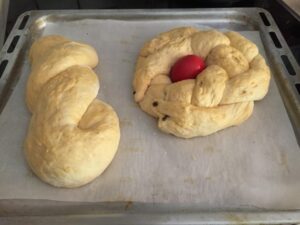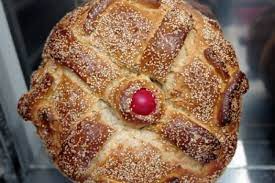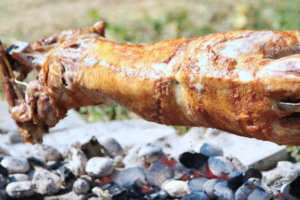 Traditionally, Easter preparations in Greece begin on the Saturday of Lazarus, a week before Easter. An aroma of freshly baked lazarakia waft through the air from all the houses. The raising of Lazarus of Bethany from the dead four days after his burial is the last of the miracles that Jesus performs before the Passion, the short final period before His death. This is commemorated during Holy Week, which is also the last week of fasting before Easter Sunday, with the crucifixion and death of Jesus, and his resurrection (Greek: Ανάστασης του Ιησού), when God raised him on the third day after his crucifixion. He appeared to his disciples, calling upon them to spread the word of forgiving sin and baptizing repenters, and then ascended to Heaven.
Traditionally, Easter preparations in Greece begin on the Saturday of Lazarus, a week before Easter. An aroma of freshly baked lazarakia waft through the air from all the houses. The raising of Lazarus of Bethany from the dead four days after his burial is the last of the miracles that Jesus performs before the Passion, the short final period before His death. This is commemorated during Holy Week, which is also the last week of fasting before Easter Sunday, with the crucifixion and death of Jesus, and his resurrection (Greek: Ανάστασης του Ιησού), when God raised him on the third day after his crucifixion. He appeared to his disciples, calling upon them to spread the word of forgiving sin and baptizing repenters, and then ascended to Heaven.
Soon after his resurrection, Lazarus traveled to Cyprus where he was appointed by Paul the Apostle and Barnabas as the first Bishop of Kition, today’s Larnaca. This is where the tradition of making ‘lazarikia’ began. These small, sweet, spicy breads are made in the shape of a man with his arms crossed and eyes decorated with cloves, to look like Lazarus wrapped in his funeral shroud. They can have the legs bound together or else with a split to create legs that represent St Lazarus walking out of his tomb. They are Nistisima (Lenten) as they do not contain any dairy or egg products. Raisins, walnuts, and honey are permitted.
While making the Lazarakia, a traditional song is sung:
Lazarus was in the tomb four days,
when Jesus came and to the Father prayed.
‘Lazarus, come forth!’, he said,
the Lord whom the five thousand fed.
Then Lazarus arose and many were in fear.
Let everyone with ears now hear.
After the ‘Lazarakia’ have been baked, there is a second song.
Where were you Lazarus?
Where was your voice?
Your mother and your sisters
were looking for you.
“I was in the Earth,
deep in the Earth buried.
and among the dead.
(Raise the ‘Lazarakia’ in the air)
Along came Christ and
Resurrected me!
Among the dead I tarried.

The tsoureki is an Easter sweet bread. In the past, the making of the tsoureki began from Holy Tuesday as the kneading then was done by hand with sourdough that takes time to rise. Today, the tsourekia, sweet, soft, fluffy, with a semi-soft brown crust and stringy texture can be made on any day of Holy Week. Many housewives make them on Holy Thursday so that they can also put a dyed red egg, which represents the blood of Christ, on them. The three braids symbolize the Holy Trinity. The two aromatic spices of mastic and mahlab give them the characteristic flavour and smell. The tsourekia are made throughout the year now and go very well with coffee.
 The making of lambrokouloura or lambropsomo is another Easter tradition. It is not a bread or a tsoureki, but something in between. Traditionally the process began on Holy Tuesday with the making of the sourdough and completed on Holy Thursday. It is a round, festive bread decorated with pieces of dough and a red egg in the middle. It is cut on the night of the Resurrection and served with magiritsa.
The making of lambrokouloura or lambropsomo is another Easter tradition. It is not a bread or a tsoureki, but something in between. Traditionally the process began on Holy Tuesday with the making of the sourdough and completed on Holy Thursday. It is a round, festive bread decorated with pieces of dough and a red egg in the middle. It is cut on the night of the Resurrection and served with magiritsa.
 Magiritsa, the Greek Easter soup, is made from lamb offal and cos lettuce, garnished with spring onions and dill, and thickened with a delicious egg lemon sauce (Greek: αυγολέμονο – avgolemono). It is prepared and served on Holy Saturday, after the midnight church service, which announces the resurrection of Jesus Christ. It is considered the best meal after the 40-day fasting period of Lent to help the digestive system back into its normal meat-eating habits. Although the Lent period is not as strict today, everyone enjoys magiritsa after the church service when they return home with their lighted candles. At the Resurrection Liturgy, just before midnight, the church goes completely dark, and the priest lights the candle with the Holy Flame that has been brought to Greece from the Church of the Holy Sepulchre (Church of Anastasis – Resurrection) in Jerusalem. The candle represents the eternal flame of Jesus and his resurrection. The lit candle is taken home where a cross is made with the flame on the doorway of the house to bless it. The candle is kept alight as the family sit around the table to eat the magiritsa, the lambrokouloura, and to crack the red eggs.
Magiritsa, the Greek Easter soup, is made from lamb offal and cos lettuce, garnished with spring onions and dill, and thickened with a delicious egg lemon sauce (Greek: αυγολέμονο – avgolemono). It is prepared and served on Holy Saturday, after the midnight church service, which announces the resurrection of Jesus Christ. It is considered the best meal after the 40-day fasting period of Lent to help the digestive system back into its normal meat-eating habits. Although the Lent period is not as strict today, everyone enjoys magiritsa after the church service when they return home with their lighted candles. At the Resurrection Liturgy, just before midnight, the church goes completely dark, and the priest lights the candle with the Holy Flame that has been brought to Greece from the Church of the Holy Sepulchre (Church of Anastasis – Resurrection) in Jerusalem. The candle represents the eternal flame of Jesus and his resurrection. The lit candle is taken home where a cross is made with the flame on the doorway of the house to bless it. The candle is kept alight as the family sit around the table to eat the magiritsa, the lambrokouloura, and to crack the red eggs.

The Easter koulouria, butter-based cookies with vanilla flavour, are usually made on Holy Thursday. Besides the small koulouria in different shapes, larger koulouria can be made so that a red egg is put on them. They are eaten on the Saturday after the eating of mageiritsa along with the cracking of the red eggs. The eggs are dyed red on Holy Thursday in commemoration of the Last Supper, the final meal Jesus shared with his Apostles in Jerusalem before his crucifixion. The red colour symbolizes life and the resurrection of Jesus Christ.
Easter Sunday is a day of celebration. It celebrates the resurrection of Jesus Christ. It is the day that everyone has been waiting for with the roasting of the lamb on the spit or in the oven and other delicious dishes to accompany it along with music and traditional Greek dancing. Most of the Greeks travel to their villages or to the islands to celebrate this important occasion with their family and friends and to wish each other Christos Anesti – Alithos o Kirios (Greek: Χριστός Ανέστη – Αληθώς ο Κύριος / Christ has risen – Truly the Lord has Risen).
